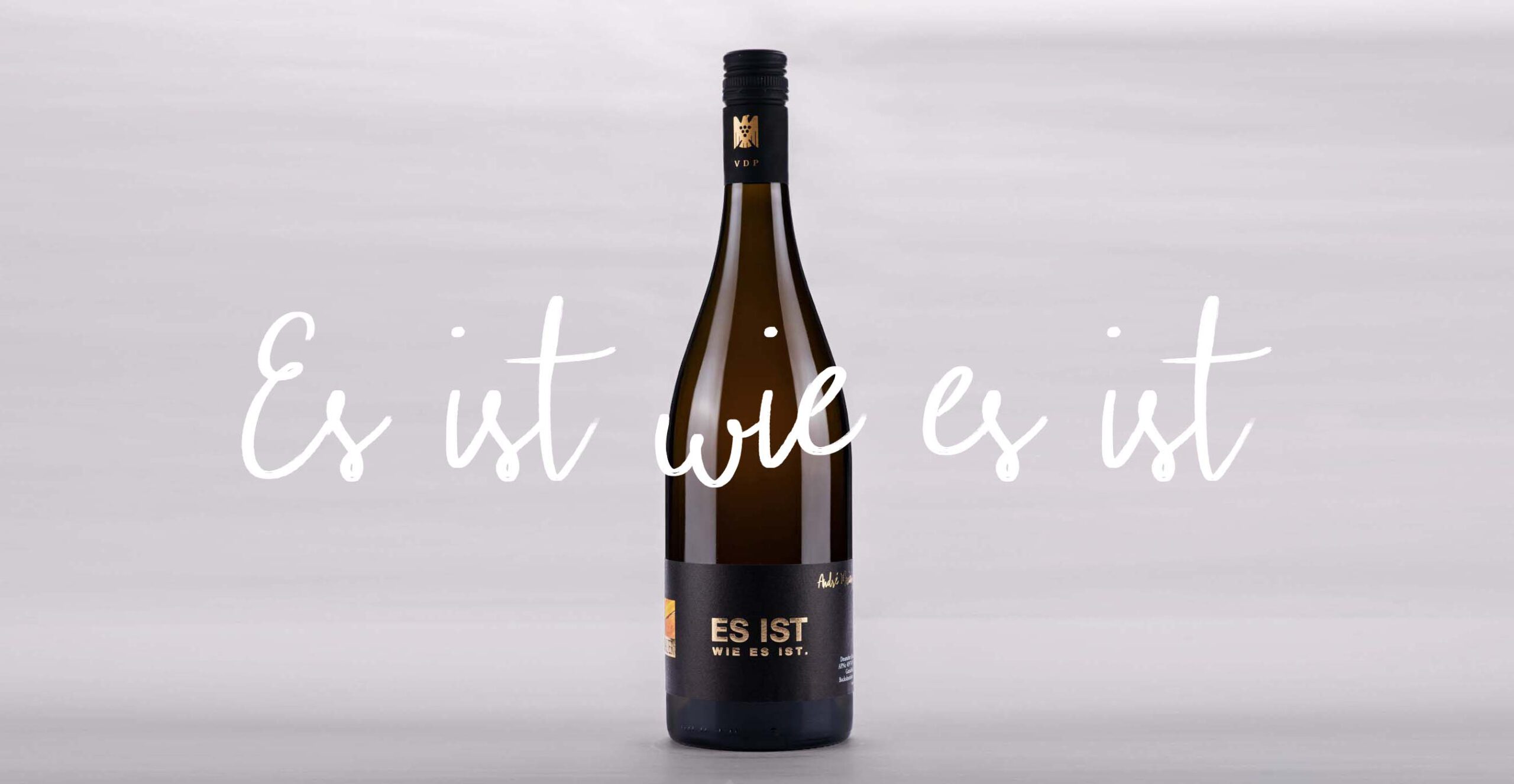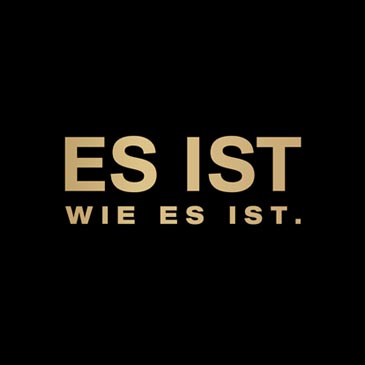
ES IST WIE ES IST
Horst Sauer & André Macionga
THE PROJECT ES IST WIE ES IST
It all started with ES IST WIE ES IST. These cuvées were my entry into the wonderful world of cuvéetting. They are complex wines with extraordinary aromas and complex flavours. Every time I travel to the wonderful Escherndorf, a great joy comes over me. The close cooperation with Horst is indeed one of the most exciting, but not the only reason why I always like to travel to the Franconian region. It is also the Escherndorfer Lump and the Escherndorfer Fürstenberg, these fantastic vineyards that are so often greeted by sunbeams. In the past years of cooperation, the Horst Sauer Winery has developed into a place of inspiration for me. Horst and I are – from a wine technical point of view – of the same nature. The cooperation is always consistent and without many words; “It is as it is”Horst Sauer is an artist and in my opinion the biggest winegrower of the Franconian region. It tells a unique story. These wines demand all the senses and thus raise the knowledge of wine to new levels.

ES IST WIE ES IST 2016
THE OPTIMAL WINE GLASS
The wine glass plays the decisive role in the perfect development of aroma. For the wine ES IST WIE ES IST 2016 I recommend the following wine glass:
Burgundy glass
THE TASTE PICTURES
FIRST TASTE PICTURE – AFTER A FRESHLY DRAWN BOTTLE
Raised directly, one recognises throughout characteristic ideas of the project “It is as it is”;. In the nose, the wine is intense, concentrated and very present – it does not need a warm-up time. The abundance of power, aroma and, despite everything, dancing lightness reflects the enormous authenticity of the project. Every year different and still the same – the signature in the sixth cuvée with Horst Sauer is unmistakable. To bring the aromatic picture, the vines, the grapes, the individual barrels to their limits, is always a joy anew. Cuvée No. 6 with base vintage 2016 also reflects the origin: the wines have always been – and still are – a little more extreme and louder, more marbled and more expressive than other cuvées. The ripeness and freshness of the wine jumps directly at my nose. An aromatic picture, which is absolutely unique in its representation. This wine is anything but boring.
SECOND TASTE PICTURE – WITH SOME OXYGEN
In the second aromatic picture, the first fullness on the palate almost gives the impression of wanting to kill you. But then: a fresh acidity that gives the wine the necessary lightness again. A cuvée that is extremely demanding and serious. The texture noticeably becomes a little denser, a little more oily, but consciously not buttery. On the palate a flood of exotic fruits, spices and indefinable aromas. It has never been so difficult for me to define a wine, because after each sip the variety of aromas doubles. In my opinion, it would be completely wrong to classify this wine in terms of taste in a grid. Due to its composition it is neither fresh, nor ripe, neither yellow, nor green, nor fruity, nor sweet. A wine where the name should be taken literally: “it is as it is”.
THIRD TASTE PICTURE – WITH A LOT OF OXYGEN
With a little more time and air, the aroma carousel becomes even wilder and more exotic. It is reminiscent of freshly picked quince, into which the recipient just bites – a dense, concentrated feeling, paired with a gentle tannin structure, which gives off a slightly furry feeling on the palate. The spice, hay-like aromas and clear creaminess of the middle part make the experience of this cuvée seem ethereal and mysterious. From an aromatic point of view, the wine is now in a place where it can hardly be grasped. We have rarely succeeded in presenting such an aromatic play of maturity, freshness, sweetness and acidity with such elegance. For all those who have already had the pleasure of enjoying one of the “it is as it is”; cuvées, No. 6 will amaze you. Every sip of this wine screams the name “It is what it is”! Aromatic and textured, the cuvée can only be reflected on the palate with great devotion and in the end is simply fun. Perhaps the most impressive wine I have ever cuvéeted and enjoyed.

ES IST WIE ES IST 2015
THE OPTIMAL WINE GLASS
The wine glass plays the decisive role in the perfect development of aroma. For the wine ES IST WIE ES IST 2015 I recommend the following wine glass:
Burgundy glass
THE TASTE PICTURES
FIRST TASTE PICTURE – AFTER A FRESHLY DRAWN BOTTLE
First there is a strong smell of exotic fruits in a dark yellow tone. The scent of lychee also resonates discreetly. In the palate I taste Williams pear and quince at the beginning. The texture is lovely and seems to be slightly waxy. A fresh citrus acid underlines the entire bouquet and makes the cuvée particularly full.
SECOND TASTE PICTURE – WITH SOME OXYGEN
In the nose, the wine now appears denser than before. The light taste of elderberry is surprising. Even now I inhale the intensively exotic note. Ripe melon and a hint of cumin complete the smell. On the palate it becomes softer and more fruity. The acidity is more subtle and rounder and thus accompanies the aromas in the finish. The quince turns more into apple, and in the acidity the note of kumquat resonates. These taste pictures remind me of a ripe, white Burgundy. The oxidative tones resemble a bottle of fine Corton Chalemagne from the 70s.
THIRD TASTE PICTURE – WITH A LOT OF OXYGEN
The intense scent of lemon in the nose reminds me for a short time of a cheesecake with lemon glaze baked by my wife. The taste of lemon is also reflected in the palate, but with a sweeter impression. Apricots and yuzu round off the taste picture. Despite numerous intense aromas, the wine is dry on the palate. Wood and earth framed by dark chocolate give this cuvée a striking finish. I am curious to see how the wine will present itself in ten years time. To the future!

ES IST WIE ES IST 2014
THE OPTIMAL WINE GLASS
The wine glass plays the decisive role in the perfect development of aroma. For the wine ES IST WIE ES IST 2014 I recommend the following wine glass:
Burgundy glass
THE TASTE PICTURES
FIRST TASTE PICTURE – AFTER A FRESHLY DRAWN BOTTLE
If my nose sniffs for the first time in the glass, I immediately perceive numerous aromas. The wine appears young and fresh, and yet one tastes the ripeness of the fruit. With my eyes closed, I feel like I’m transported back to late summer. At this time of year in Lower Austria – Wachau to be precise – the trees are full of apricots. I smell apricot jelly. The first sip tastes mineral and parallels enormously with concentrated yellow fruit. This yellow fruit reminds me of a dark yellow compote. It contains a light sweetness reminiscent of caramel, yet the wine has a harmonious acidity. A perfectly fermented grape juice.
SECOND TASTE PICTURE – WITH SOME OXYGEN
In the nose, the cuvée now becomes wilder. The smell of apricot becomes dominant and makes a heavy impression. Now you can smell the sweetness of the caramel in your nose. The texture on the palate is now very round. The wine makes a charming impression, and yet the corners and edges are clearly visible. They are noticeable in the form of citrus notes. Sweetness becomes more dominant. It looks bitter and dark. The texture is now strikingly in harmony with the taste. The wine texture underlines the aroma structure and gives the drinker a visual experience. The fruit, the acidity and the texture are in fantastic balance.
THIRD TASTE PICTURE – WITH A LOT OF OXYGEN
The aroma image of the apricot remains present. The dark yellow tone dawns even more, and everything looks more sumptuous on the palate now. With the darkening a dense spice of wood and fruit appears. Another adventure in the world of flavours.

ES IST WIE ES IST 2013
THE OPTIMAL WINE GLASS
The wine glass plays the decisive role in the perfect development of aroma. For the wine ES IST WIE ES IST 2013 I recommend the following wine glass:
Burgundy glass
THE TASTE PICTURES
FIRST TASTE PICTURE – AFTER A FRESHLY DRAWN BOTTLE
The first thing that appears in the nose is the strong smell of dried fruit. The wine presents itself already after opening the bottle in a multicoloured aroma world. Complex aromas, exciting textures and lots of refinement. In addition, the scents of ginger, galangal and rose blossom can be found in the nose. Fantastic. The aroma world of the nose is also reflected in the first palate contact. The texture resembles the finest cashmere. The aromas unfold quickly. The bouquet of this cuvée is undoubtedly sophisticated.
SECOND TASTE PICTURE – WITH SOME OXYGEN
Now I hold my nose into the glass, smell a dry sweetness and see clear orange tones in front of me. The variety of spices that rise in my nose make me fly directly to India in fractions of a second. The creamy texture remains. The mouth also tastes this palette of spices. You remind me of a palm tree beach. Accompanied by strong beeswax and earthy peat. Then it becomes tropical: the acidity of passion fruit, the sweetness of mango and the floral smell of vanilla pod complete the taste picture. Discreet structures of dry leather round off the tropical note in the finish.
THIRD TASTE PICTURE – WITH A LOT OF OXYGEN
In the nose – in addition to the spices – crunchy almonds and a cool tone gently knock on the door. At the end of this journey, the aroma world of this cuvée moves on to the southern Rhône. Rich honey tones that appear dry and dense. This taste reminds of a white Châteauneuf-du-Pape. With more time and oxygen, the third cuvée “Es ist wie es ist”; (It is as it is) develops more and more into a symphony of the world of taste. For me, this cuvée is like a key that takes me through doors to other countries and cultures.

ES IST WIE ES IST 2012
THE OPTIMAL WINE GLASS
The wine glass plays the decisive role in the perfect development of aroma. For the wine ES IST WIE ES IST 2012 I recommend the following wine glass:
Burgundy glass
THE TASTE PICTURES
FIRST TASTE PICTURE – AFTER A FRESHLY DRAWN BOTTLE
It is the salty minerality that makes me drift to France, the bay of Arcachon, when I inhale for the first time. A note that reminds me of mussels, combined with a floral scent. The freshly opened bottle shows discreet, resinous tones on the palate with a youthfully fresh acidity.
SECOND TASTE PICTURE – WITH SOME OXYGEN
And the journey continues. From Arcachon the journey of tastes continues to Italy. In my inner eye I see Vongole, clams. Fresh orange zest blends into the bouquet. On the palate a fine sweetness is formed, which gives the wine a creamy, silky texture. Despite all its facets, the wine is consistently strong, dynamic and fresh.
THIRD TASTE PICTURE – WITH A LOT OF OXYGEN
In the nose the wine appears more and more complete, but still fresh. The taste of Vongole, perfectly prepared, refined with mint and basil, freshly picked from the garden, fills my nose. Now the drinking acid rises on the palate. The texture becomes resin-like. Surprisingly the journey now goes to the Orient. Raisins, saffron, orange, a hint of cumin and a delicate sweetness of violet violets harmoniously round off the picture of the aroma world. This cuvée is as enchanting for the senses as a thousand and one nights.

